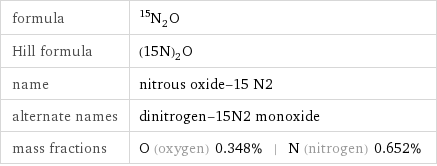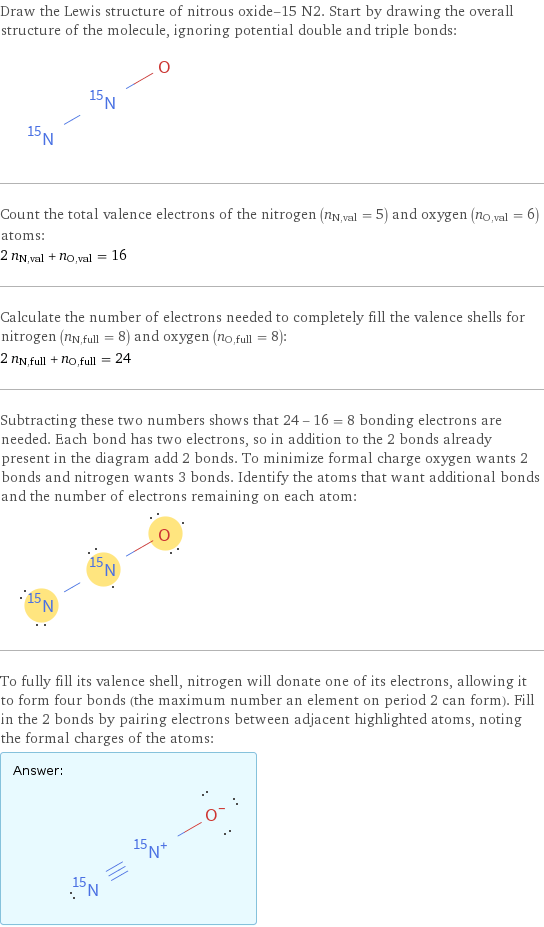Input interpretation

nitrous oxide-15 N2
Chemical names and formulas

formula | ^15N_2O Hill formula | (15N)_2O name | nitrous oxide-15 N2 alternate names | dinitrogen-15N2 monoxide mass fractions | O (oxygen) 0.348% | N (nitrogen) 0.652%
Lewis structure

Draw the Lewis structure of nitrous oxide-15 N2. Start by drawing the overall structure of the molecule, ignoring potential double and triple bonds: Count the total valence electrons of the nitrogen (n_N, val = 5) and oxygen (n_O, val = 6) atoms: 2 n_N, val + n_O, val = 16 Calculate the number of electrons needed to completely fill the valence shells for nitrogen (n_N, full = 8) and oxygen (n_O, full = 8): 2 n_N, full + n_O, full = 24 Subtracting these two numbers shows that 24 - 16 = 8 bonding electrons are needed. Each bond has two electrons, so in addition to the 2 bonds already present in the diagram add 2 bonds. To minimize formal charge oxygen wants 2 bonds and nitrogen wants 3 bonds. Identify the atoms that want additional bonds and the number of electrons remaining on each atom: To fully fill its valence shell, nitrogen will donate one of its electrons, allowing it to form four bonds (the maximum number an element on period 2 can form). Fill in the 2 bonds by pairing electrons between adjacent highlighted atoms, noting the formal charges of the atoms: Answer: | |
Basic properties

molar mass | 45.999 g/mol phase | gas (at STP) melting point | -91 °C boiling point | -88 °C
Units

Gas properties (at STP)

vapor density | 1.53 (relative to air)
Non-standard atom properties

N-15 | 2
Chemical identifiers
![CAS number | 20621-02-7 PubChem CID number | 12622056 PubChem SID number | 24872554 SMILES identifier | N#[N+][O-] InChI identifier | InChI=1/N2O/c1-2-3/i1+1, 2+1 MDL number | MFCD00084234](../image_source/51d8e50107c367c820f23d1823513086.png)
CAS number | 20621-02-7 PubChem CID number | 12622056 PubChem SID number | 24872554 SMILES identifier | N#[N+][O-] InChI identifier | InChI=1/N2O/c1-2-3/i1+1, 2+1 MDL number | MFCD00084234